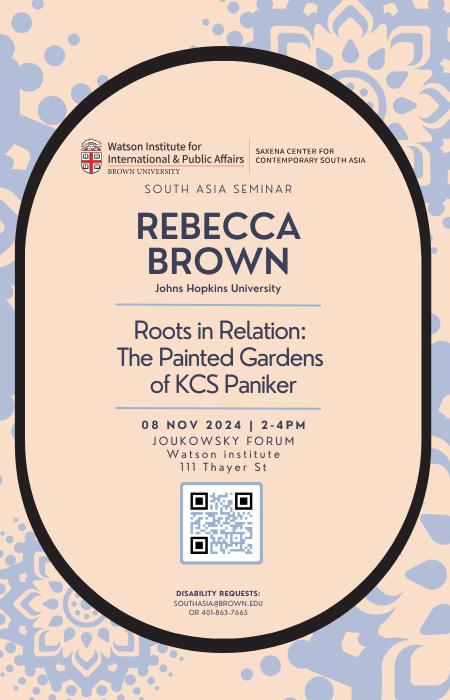Friday, November 8, 2024
2:00pm - 4:00pm EST
Joukowsky Forum, 111 Thayer St
One can almost hear the cacophony of parakeets as their green bodies punctuate the branches of a tamarind tree. In another work, a dog, somewhat emaciated, back curved, stares out at us from a milky grey-blue background. In another, a cheery octopus cavorts in the curve of a river; over here, monkeys hang from branches in a crowded field of pink and blue pastel vegetation. The paintings of Madras-based artist KCS Paniker from the 1960s and 1970s explode with vibrant life, both vegetal and animal. They often, and in the same painting, overwhelm us with written symbols and passages of what look like text. Thus, Paniker’s work is not landscape painting, nor is it a critical rethinking of the long global history of animal studies from the turkey portrait by the seventeenth-century Mughal artist Mansur to the staged birds of the Audubon Society. Paniker’s work does not depict nature in any imaginary pure state, instead giving us a pruned, selected vision of trees, animals, birds, and plants alongside the marks humans make to seek understanding of the world: math equations, astrological diagrams, textual scrawls, magic symbols. Brown reads his work as outlining an ecology of human-animal-plant mutuality, one that presents painted, curated “gardens.” In these works, we can see the embedded dependencies of the modern—dependence of the human and non-human, yes, and also dependence on the languages of modern painting itself: birds, color, a tree, a symbol, a dog, a chart, a monkey, a line. Paniker drew from a long history of exploring these intersections in modern art alongside the history of engagements with the animal, the human, and the otherworldly in a range of South Asian contexts. His paintings offer us the “modern” through an ecology of painted gardens.
Rebecca M. Brown's writing engages with the art, architecture, and visual culture of South Asia and its diasporas from the late eighteenth century to the present. She is particularly interested in the tensions and struggles that emerge within visual culture at moments that present themselves as transitional (but usually do not constitute a true “break”)—the early British presence on the subcontinent, the anti-colonial movement of the early twentieth century, the decades after India’s independence in 1947, and the economic and political machinations of the long 1980s. She has written on urban space, architecture, cemeteries, amateur lithographs, popular painting, photography, modernist painting and sculpture, film, television, and museum display.
Her current research focuses on the painting and editorial work of K.C.S. Paniker (1911–77), which evinces a rich mode of experimentation with gesture, color, and line to deeply question the foundations of knowing in a fraught postcolonial linguistic and political landscape of southern India. Throughout her work, Brown is attentive to the interplay between space and the activities it shapes and enables, as well as the temporality of movement, performance, and duration as embodied by textiles, photographs, paintings, and people. At the core of each of these engagements lies a commitment to visual culture in its materiality, its instability, its active role for history, and its reconstitution in different epistemes under changing political demands.
She is honored to serve as chair of the Advanced Academic Programs in Museum Studies and Cultural Heritage Management at Johns Hopkins. She has also served as a consultant and a curator of modern and contemporary Indian art for the Peabody Essex Museum, the Walters Art Museum, and the Shelley and Donald Rubin Foundation. Her academic career has enabled her to teach across North America and in the UK, at institutions including St. Mary’s College of Maryland, Swansea University, Georgetown University, and George Washington University. She has had the privilege of speaking to a wide range of audiences, at venues ranging from the Art Seminar Group of Baltimore to the Clark Art Institute and the National Museum of Korea.
Rebecca M. Brown received her BA in the History of Art from Pomona College and her PhD in South Asian and Islamic Art History from the University of Minnesota, working with Frederick M. Asher and Catherine B. Asher. Throughout her academic career, she has actively developed undergraduate courses in Asian and Islamic art, created innovative approaches to the art history survey, and led seminars in Asian studies, gender studies, museum studies, postcolonial theory, film studies, and art historical methodology.


